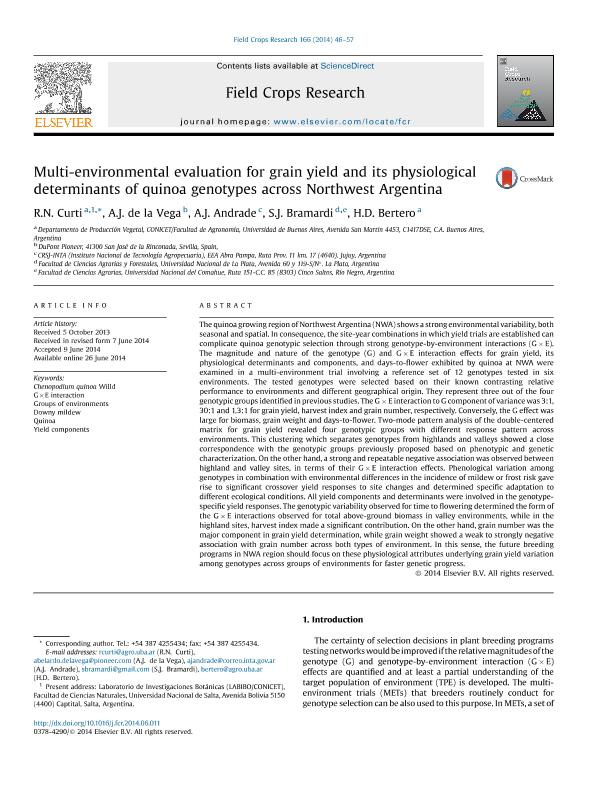Artículo
Multi-environmental evaluation for grain yield and its physiological determinants of quinoa genotypes across Northwest Argentina
Curti, Ramiro Nestor ; de la Vega, A. J.; Andrade, A. J.; Bramardi, Sergio Jorge; Bertero, Hector Daniel
; de la Vega, A. J.; Andrade, A. J.; Bramardi, Sergio Jorge; Bertero, Hector Daniel
 ; de la Vega, A. J.; Andrade, A. J.; Bramardi, Sergio Jorge; Bertero, Hector Daniel
; de la Vega, A. J.; Andrade, A. J.; Bramardi, Sergio Jorge; Bertero, Hector Daniel
Fecha de publicación:
07/2014
Editorial:
Elsevier Science
Revista:
Field Crops Research
ISSN:
0378-4290
Idioma:
Inglés
Tipo de recurso:
Artículo publicado
Clasificación temática:
Resumen
The quinoa growing region of Northwest Argentina (NWA) shows a strong environmental variability, both seasonal and spatial. In consequence, the site-year combinations in which yield trials are established can complicate quinoa genotypic selection through strong genotype-by-environment interactions (G × E). The magnitude and nature of the genotype (G) and G × E interaction effects for grain yield, its physiological determinants and components, and days-to-flower exhibited by quinoa at NWA were examined in a multi-environment trial involving a reference set of 12 genotypes tested in six environments. The tested genotypes were selected based on their known contrasting relative performance to environments and different geographical origin. They represent three out of the four genotypic groups identified in previous studies. The G × E interaction to G component of variance was 3:1, 30:1 and 1.3:1 for grain yield, harvest index and grain number, respectively. Conversely, the G effect was large for biomass, grain weight and days-to-flower. Two-mode pattern analysis of the double-centred matrix for grain yield revealed four genotypic groups with different response pattern across environments. This clustering which separates genotypes from Highlands and Valleys showed a close correspondence with the genotypic groups previously proposed based on phenotypic and genetic characterization. On the other hand, a strong and repeatable negative association was observed between Highland and Valley sites, in terms of their G × E interaction effects. Phenological variation among genotypes in combination with environmental differences in the incidence of mildew or frost risk gave rise to significant crossover yield responses to site changes and determined specific adaptation to different ecological conditions. All yield components and determinants were involved in the genotype-specific yield responses. The genotypic variability observed for time to flowering determined the form of the G × E interactions observed for total above-ground biomass in Valley Environments, while in the Highland sites, harvest index made a significant contribution. On the other hand, grain number was the major component in grain yield determination, while grain weight showed a weak to strongly negative association with grain number across both types of environment. In this sense, the future breeding programs in NWA region should focus on these physiological attributes underlying grain yield variation among genotypes across groups of environments for faster genetic progress.
Archivos asociados
Licencia
Identificadores
Colecciones
Articulos(CCT - SALTA-JUJUY)
Articulos de CTRO.CIENTIFICO TECNOL.CONICET - SALTA-JUJUY
Articulos de CTRO.CIENTIFICO TECNOL.CONICET - SALTA-JUJUY
Articulos(OCA PQUE. CENTENARIO)
Articulos de OFICINA DE COORDINACION ADMINISTRATIVA PQUE. CENTENARIO
Articulos de OFICINA DE COORDINACION ADMINISTRATIVA PQUE. CENTENARIO
Citación
Curti, Ramiro Nestor; de la Vega, A. J.; Andrade, A. J.; Bramardi, Sergio Jorge; Bertero, Hector Daniel; Multi-environmental evaluation for grain yield and its physiological determinants of quinoa genotypes across Northwest Argentina; Elsevier Science; Field Crops Research; 166; 7-2014; 46-57
Compartir
Altmétricas



